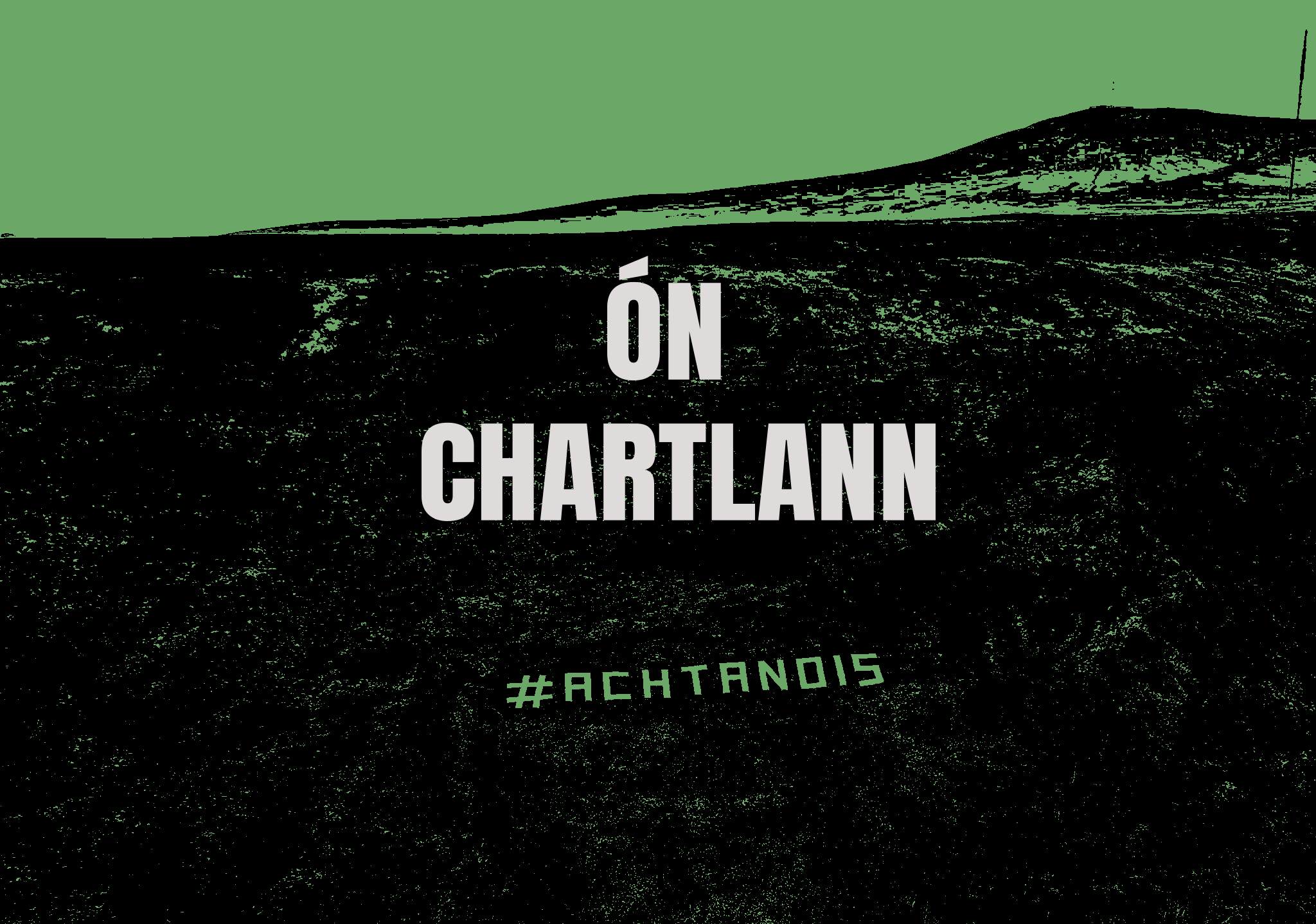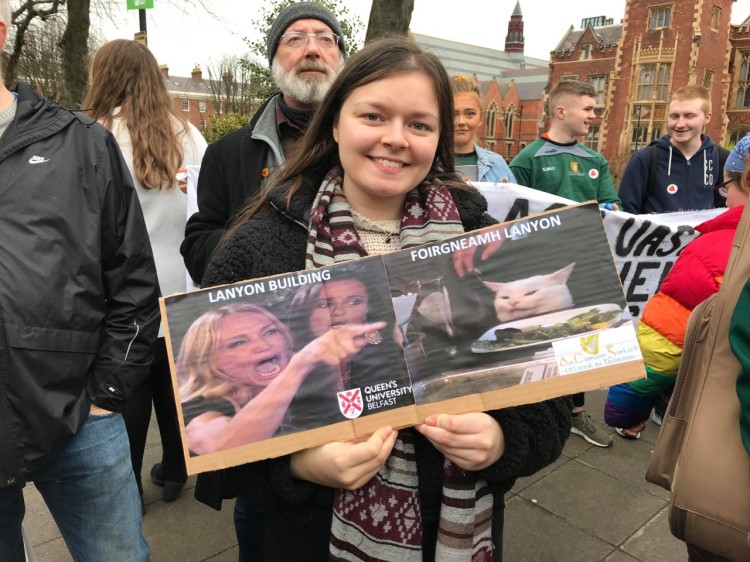An litir dhearg
Bí ar an eolas! Faigh ár nuachtlitir le bheith suas chun dáta leis na feachtais ar fad.



What would you say drives the desire to have bilingual signage on campus, both in Irish and English?
Eoghan: The thing with the Irish culture and language is that it’s a shared culture and language, so bilingual signage would increase its visibility, as well as hearing the language, which creates a shared space in the university. This creates a vacuum for cross community relations, like we’ve done so far in the past two years. The mix of Irish speakers from different backgrounds who all get involved with an Cumann Gaelach has been incredible. Not only for cross community relations but for international students, who come here to Queen’s and see only monolingual signs and language; there’s no sign of the rich history and culture that exists on this island. Signs show that the language is here, there are people living here who speak Irish and are involved in its culture.
Your social media campaign is very successful, with a huge level of engagement, not just from students at Queen’s, but anyone at all interested in Irish. Do you feel that your social media campaign has played a big part in the growth of your society?
Jack: It’s not only made us as a larger society but it’s allowed us to have a bigger reach, with different Cumman Gaelachs around the country retweeting and sharing our posts, giving us support. Not just Cumman Gaelachs, but people who are involved in the Irish community in general. I think that if the social media presence wasn’t there, our awareness wouldn’t be as big, but I still believe the Cumman Gaelach at QUB would have as big a membership with popular demonstrations and events. Social media does give you the chance to plaster your message everywhere and get out to that wider audience.
I’ve learnt from the social media campaign that it was twenty-two years ago that QUB removed the bilingual signage that was on the old Student’s Union. The quote given in the explanation was that, “it was not compatible with a neutral working environment”, politicising the signage. Do you feel like that attitude on campus has changed or still persists?
Jack: I definitely think the attitude has changed amongst students, especially when we see the responses we get about our campaign; they’re more overwhelmingly positive than anything else. But you often find within the institution of Queen’s itself, the attitudes hardly change. You can see with the response we got from the Vice Chancellor, calling the Irish language “provocative”. But that’s usually always the cause, where the institution stalls while the union is progressing on. We, as part of the Students’ Union, are progressing as the student body itself is progressing.
Eoghan: It’s important because that answer was from twenty-two years ago, and it would be good to see a refreshed answer on the situation – is that answer from QUB, which was used to take down bilingual signage, the same answer now in 2019? No doubt the institution was under pressure 22 years ago, with the political factors that were behind the decision, but it would be good to see an updated response for the different time we’re in now.
Last year, the Students’ Union voted overwhelmingly to elect an Irish Language Officer, so do you feel that bilingual signage is the next step towards the normalisation of the Irish language on the campus?
Eoghan: Absolutely, if we look at other universities in Ireland, for example Galway, it’s a bilingual university with bilingual signage, a permanent Irish language officer, bilingual courses and shared spaces for workers who are directly employed for the Irish language. We look at universities like Galway and see a successful bilingual policy, and that’s what we’re striving for as well; not just physical visibility, but an actual bilingual policy for the university. A part-time Irish language officer is definitely a step in the right direction, with better resources and involvement with the Students’ Union, although we’ve already got great support from the Students’ Union Council. But having an Irish Language officer who students who speak Irish can go to in confidence for advice is a massive achievement. My whole life I’ve been educated through the medium of Irish, so coursework and exams in English was entirely new to me. If there was an Irish language officer there when I first came to Queen’s, I would have definitely gone to them for advice.
How important is visibility of the language to Irish speakers?
Eoghan: In the past, the Cumann Gaelach was quite inactive, but the membership in the past two years alone has nearly doubled. It’s clear how keen people are now to get involved and I think if the Irish language isn’t visible, then students coming from Irish-medium schools don’t feel that the opportunity to hear and speak the language is there and it can stop people from actively getting involved. Because of the increased visibility in the past two years, you can hear Irish being spoken around campus; it all normalises Irish and creates a comfortable environment for speakers.
Jack: We’re not a bottomless campaign, there’s substance in it. We’re not campaigning for bilingual signage then speaking English to each other; we’re all heavily immersed in Irish culture and we speak Irish to each other daily. All our meetings are through Irish, when we’re in a café with our friends we’re speaking in Irish. It’s the language that we speak and it’s not everybody’s first language. I wasn’t educated through Irish, but it’s what I feel most comfortable speaking. Irish is what I associate with speaking to my friends; it’s not just a sign, it’s a culture and an identity. We’re not in a political society, it’s not our fault we have to get involved in what’s happening but it’s just how things have panned out. We’re most importantly a social society, where people can speak Irish and spend time together.
Does an Cumman Gaelach view its campaign as political?
Eoghan: The campaign itself is social and political, because like Jack said, if you look at who has politicised the Irish language, describing it as “provocative, offensive and intimidatory”, it wasn’t us who began this. While Queen’s accepted its policy had to change in 2018, it was comments made in a letter by then Vice Chancellor Professor James McElnay that led to this. The consultation process on Irish signage was extended from two weeks to over the whole summer, because of ‘lack of submissions’, when we as a society received over 1000 submissions, including hundreds online. So we’ve been pushed towards this protest.
What would you say is the goal of an Cumman Gaelach for an Irish language policy at Queen’s?
Jack: It’s hard to quantify, but the main aim is for Irish speakers to feel respected so that we can see the visibility of our language and feel equal as Irish speakers. I think that when that’s felt, that’s when we’ll know we’ve achieved what we set out to do. Bilingual signage is of course part of that, but I think that respect and the feeling of equality really is our aim.
Eoghan: What we stand by is the bilingual policy, which is what we’re trying to achieve. The monolingual policy here at Queen’s is discriminatory against Irish speakers, and so we’re trying to push for an equal bilingual policy to counter this. A bilingual policy could mean bilingual signage, shared space, and hopefully in the future, bilingual courses. It’s not that one language or culture is better than the other, but this would be a recognition that there’s a huge mass support for the Irish language and culture at Queen’s and in the wider society. There’s more young people and adults learning Irish now than ever before, and we want to see the normalisation of the language on our campus.
Bí ar an eolas! Faigh ár nuachtlitir le bheith suas chun dáta leis na feachtais ar fad.